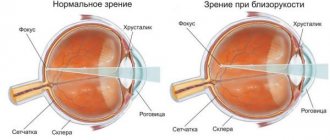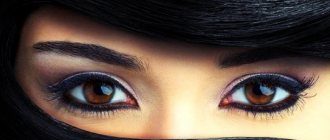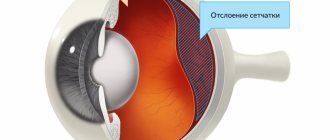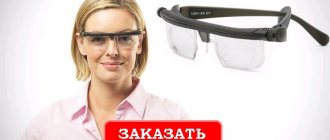The main dangers to our vision and methods of protecting against them
- Myopia is the main danger Influencing factors and statistics
- Methods to combat progressive myopia
- Consequences of exposure to hazardous radiation on the eyes
While gadget developers are excited about their latest advances, vision care professionals are sounding the alarm about the damage that modern living conditions are causing to their patients' vision. Let's discuss what dangers to vision concern ophthalmologists and what means they resort to in order to minimize these dangers.
Myopia is the main danger
Influencing Factors and Statistics
Myopia, or myopia, is the most common type of visual impairment, occurring in approximately 30% of the world's inhabitants. As for children and adolescents, the incidence of myopia among them varies from 6 to 50%, depending on age and the number of years devoted to education. Thus, over the past few years in Seoul this figure was 96%, and in Shanghai – 95.5%, which suggests a real epidemic of myopia in Asian countries, especially among students. GfK announced that soft contact lens revenue in the Asia-Pacific region increased by 2.2% in the first eight months of 2020 alone, reaching US$652 million, as vision deteriorated in the Asia-Pacific region. The likelihood of developing myopia is influenced by many factors, including age, gender, heredity, level of education, type of work, lifestyle, etc. As a result of an epidemiological study conducted in the USA in 2020, it was revealed that even race plays an important role here . Thus, myopia occurs in 1.2% of American light-skinned children, 3.7% of Hispanic children, 3.98% of Asian children and 6.6% of African American children.
The most significant factor influencing the development of myopia is considered to be high visual load, which only increases every year.
In Russia, as the results of the All-Russian medical examination show, the incidence of myopia in children and adolescents has increased 1.5 times over the past 10 years. The proportion of children with myopia reaches 26% among secondary school graduates, and by the time they graduate from high school or lyceum, this figure is already 50%. Among university students, the proportion of myopic people is even higher. High myopia (more than 6.00 diopters) is observed in 10–12% of students in Russia.***
The visual load of people of different ages has increased today to an even greater extent due to the increased popularity of tablet computers, smartphones and other mobile devices equipped with displays. This situation, according to scientists, will contribute to an even greater prevalence of myopia among representatives of a wide variety of populations and races (Fig. 1).
Rice. 1. Forecasts for an increase in the prevalence of myopia among representatives of different races (using the example of US citizens), million people: ■ – all; ■ – white; ■ – blacks; ■ – Latin Americans; ■ – others
Methods to combat progressive myopia
Myopia, especially at an early age, is fraught not only with refractive error, but also with very serious consequences for the eyes and vision. This includes myopic macular degeneration, retinal detachment, and even the development of glaucoma and cataracts. As a result, it negatively affects the quality of life of patients and causes significant economic damage to society as a whole. According to researcher Noel Brennan, a 33% reduction in the rate of myopia development would result in a 73% reduction in the number of patients with myopia greater than 5.00 D, and a 50% reduction in the rate of myopia development would result in 90% less. Therefore, much attention of scientists is aimed at increasing the effectiveness of controlling progressive myopia in children and adolescents. Experts strive to achieve this by selecting orthokeratological lenses for young patients, soft multifocal lenses of a special design, as well as through the instillation of atropine eye drops. As for preventive measures, one of them is the child’s active pastime in the fresh air. This is confirmed by the results of several epidemiological studies conducted in the United States, indicating a correlation between the duration of outdoor exposure and the degree of development of myopia. The mechanisms behind this are not yet fully understood. One theory is that exposure to more intense daylight stimulates the production of dopamine, a neurotransmitter that scientists believe inhibits the process of axial elongation of the eyeball.
Active child spending time in the fresh air is a preventive measure to prevent the development of myopia
Ultraviolet radiation and blue light
Consequences of exposure to hazardous radiation on the eyes
Today, vision care professionals are increasingly encouraging their patients to protect their eyes from the harmful effects of ultraviolet (UV) rays. There are also warnings about the harmful effects of blue light on the eyes. Let's discuss these two dangers to our vision in more detail, as well as how to protect ourselves from them. Many people know that natural light can have both beneficial and harmful effects on our body. An integral component of sunlight is ultraviolet, which belongs to the invisible part of the spectrum. Its effects on the eyes are especially harmful to the cornea and lens. It can accumulate, so over the years the development of cataracts, pterygium and some other eye diseases may begin.
Exposure to UV radiation is dangerous even on a cloudy day: up to 80% of UV rays can pass through clouds.
Blue, or more precisely violet-blue, light belongs to the visible part of the spectrum. It easily reaches the posterior segment of the eye (Fig. 2), and its effects, aggravated by the cumulative effect, cause damage mainly to the retina. In addition, blue light waves of a certain length (from 415 to 455 nm) lead, according to researchers, to the development of age-related macular degeneration. Depending on the time of day and weather conditions, sunlight can contain between 25 and 30% blue light.
Rice. 2. Areas of harmful effects on the eye from UV rays and blue light: ■ – UV radiation; ■ – blue light 1 – sclera; 2 – cornea; 3 – pupil; 4 – lens; 5 – iris; 6 – ciliary body; 7 – choroid of the eye; 8 – retina; 9 – center of the macula; 10 – optic nerve
However, the greatest danger to the eyes is blue light, which is emitted by the screens of various gadgets and such modern lighting sources as light-emitting diode (LED) and compact fluorescent lamps.
It's no surprise that every year our eyes are exposed to more and more intense blue light. According to scientists, by 2020, in 90% of cases, LED lamps will be used as lighting sources. The fact that protecting your eyes from UV rays and blue light is becoming increasingly important is supported by statistics. In the United States, 24 million people were recently diagnosed with cataracts. over 40 years old, which is 19% higher than in 2000. And age-related macular degeneration (AMD) affects approximately 2 million people in this country today, which is 25% higher than in 2000. It is expected that by 2050 the number of patients with cataracts will increase to 50 million people, and with AMD - to 5 million people****.
Protect your eyes from UV rays and blue light
Complete eye protection from harmful UV radiation can only be comprehensive.
It involves the use of several accessories at once. First of all, these are sunglasses with high-quality lenses that provide reliable protection from frontal UV rays. You also need contact lenses with a UV filter, which will prevent the penetration of side and reflected rays of the sun into the internal structures of the eye. A wide-brimmed headdress will help protect you from the rays falling from above. Before we talk about protection from the harmful effects of blue light on the eyes, I would like to make one remark. There is blue, or more precisely blue-turquoise, light that is beneficial for the eyes and general health of a person, the wavelength of which is in the range from 465 to 495 nm. For our vision, in particular for the pupillary reflex, this light is very important. It also has a regulatory effect on circadian rhythms. That is why insufficient exposure to blue-turquoise light on the human body leads to a malfunction of his biological clock, that is, to disruption of periods of sleep and wakefulness. In view of the above, eye protection from blue light should be selective. Spectacle lenses with special optical coatings provide such protection. One of the leaders in the creation of such coatings is the Essilor Group, which, together with the Paris Vision Institute, once set a goal to develop a selective light filter that blocks UV radiation and rays of the blue light spectrum that is harmful to the eyes. The fruit of their efforts was the optical coating Crizal Prevencia, which protects the eyes from dangerous blue-violet light and transmits blue-turquoise light, which has a beneficial effect on human well-being. Other equally successful developments in this area include the following optical coatings: Blue Control (Hoya Vision Care), eNERGY (Indo Int.), Neva Max Blue UV (BBGR), SeeCoat Blue UV (Nikon), Super Resistant Blue (Seiko Optical Products), Tokai Blue (Tokai Optecs NV), as well as less well-known on the Russian market Happy Lens (Spy Optic Inc.), iBlu coat (PFO Global), Recharge (Hoya Vision Care), Unity BluTech (VSP). A number of manufacturers use this kind of filters in the manufacture of lenses for their sunglasses. Among them is the Silhouette company, which recently introduced sun clip-ons/clips, or special overlays for regular Silhouette brand glasses, which not only provide full protection from ultraviolet radiation, but also filter out a significant part of the harmful spectrum of blue light. As we have seen, modern technologies and lifestyles place increased strain on our eyes, and therefore we need appropriate means to prevent further deterioration of vision. Research efforts are also revealing additional risk factors for our eyes, such as harmful blue light, and manufacturers are responding with developments to minimize the harmful effects of blue light. The use of all these innovations will help patients not experience any special vision problems for many years, keeping up with the living standards of modern society. *Data provided by the professor of the Federal State Budgetary Institution “Moscow Research Institute of Eye Diseases named after. Helmholtz" of the Ministry of Health of Russia, Dr. of Biol. Sciences E. N. Iomdina. **Statistics taken from the report. *** Data provided by Professor of the Department of Ophthalmology of the RUDN University, Dr. med. Sciences E. Yu. Markova. **** The paragraph contains statistics from the National Eye Institute presented on its website. URL: https://www.nei.nih.gov/eyedata/cataract (accessed 10/31/2017).
Alexander Kozlovtsev
Vision Day: 7 facts about our eyes
October 12 is Vision Protection Day.
Photo: Ivan VISLOV
1. Children with strabismus see the world as flat.
This is true. And many still perceive strabismus (and it occurs in about 10 percent of children) as a purely aesthetic defect.
Meanwhile, with strabismus, the functions of all parts of the visual analyzer are disrupted - from the periphery to the visual centers of the cerebral cortex. A child with strabismus cannot merge images from both eyes into a single image - he sees the world as flat because he cannot perceive spatial volume, i.e. 3D format.
Therefore, our task in treating strabismus is to achieve three things: to restore the symmetrical position of the eyes through surgery, to achieve high visual acuity in the squinting eye, and to restore the ability for three-dimensional stereoscopic vision.
2. You can change your eye color without lenses.
The first operations to remove brown eye pigment are now being carried out on volunteers in America and Europe. Soon they will be able to make them in Russia. There are no medical indications for this procedure. It's purely cosmetic.
The more often you look at the sun without glasses, the higher the chance of going blind.
Photo: GLOBAL LOOK PRESS
3. Ultraviolet radiation can make you blind.
Yes. And the more often you look at the sun without glasses, the higher the chance. Due to the damaging effects of ultraviolet rays, so-called age-related macular degeneration develops. It appears after 45-50 years and is the most common cause of blindness in the modern world.
To protect your eyes from the harmful effects of UV rays, you must wear sunglasses that can block these rays. Therefore, when choosing such glasses, be sure to check the markings confirming the degree of protection against ultraviolet radiation. The optimal value is UV 400 - glasses are able to maximally filter out rays with a wavelength of less than 400 nanometers, that is, all rays that can harm the eye7
4. All children are born farsighted.
At birth, all babies have farsightedness of about 3 diopters. As the child gets older and the eyeball grows, farsightedness usually disappears. This is due to the fact that the size of the eye lengthens.
If this does not happen, problems arise: farsighted children have poor vision both in the distance and near. Therefore, during prolonged exercise at close range, people may complain of headaches and fatigue when reading, drawing or writing.
By the way, if farsightedness in children is not treated, then in about 40% of cases strabismus develops. But farsightedness is highly treatable if it is treated promptly. Then you can get rid of farsightedness and prevent complications from occurring.
School performance may be impaired due to poor vision.
Photo: Alexey BULATOV
5. Poor performance at school - due to poor eyesight.
About 40% of the cerebral cortex is involved in servicing the visual system, and the remaining 60% solves all other tasks. Imagine what happens if a child has a “breakdown” of the visual system?
Of course, serious diseases of the visual system are the cause of poor performance at school and psychological problems with peers. This includes strabismus, nystagmus, and even the more common myopia, farsightedness, and astigmatism, when the child needs to wear glasses.
6. The human eye sees only three colors: red, blue and green.
Yes. And the rest of the colors are a combination of these colors. If the perception of any of these colors is impaired, then color blindness develops, the presence of which can be checked using special tables.
Men are more often affected by color blindness: every 12th male representative is color blind. All daughters of a person with color blindness will be carriers of the gene.
7. Eye gymnastics will not help restore good vision.
The retina is formed in the fetus in the womb from the same structures as the brain. Therefore, the retina and optic nerve have a direct relationship with the brain. Even the structure of the layers of the retina resembles the structure at the cellular level of the brain. How can you correct disturbances at such a deep level by moving your eyes from side to side? Gymnastics cannot treat eye diseases. This is a pure anachronism that continues to be preached.
FACT
Inexplicably, it is impossible to sneeze with your eyes open.
It is impossible to sneeze with your eyes open.
Photo: GLOBAL LOOK PRESS
IMPORTANT
Strabismus can develop due to smartphones
Recently, a group of South Korean scientists published an interesting study. Patients aged 7 to 16 years used a smartphone for an average of 6 hours daily for 4 consecutive months. The average angle of strabismus in the subjects at the end of the experiment was 10 degrees. After reducing smartphone use for 1 month, patients experienced a decrease in strabismus.
This happens because a person needs two eyes to look not at a plane, but to evaluate the world around him in its entirety. If a young person looks at a plane for a long time, then the brain adapts in such a way as to look with one eye, since it is easier to look for a long time with one eye than with two. That is why such strabismus develops, which is, in fact, adaptive to new conditions of visual work.
TO THE POINT
Myopia is hereditary
40-50% of children inherit myopia if one of the parents has myopia, and 80% - if both parents have myopia. By the way, if grandparents read without glasses at the age of 50, then they are nearsighted; others begin to develop farsightedness at this age. And myopia is much more often transmitted from grandparents. And now there is even a special program in which you can calculate what “minus” a child will have by the age of 18, given the current dynamics and heredity.
Of course, the development of myopia is also influenced by excessive visual stress and a love of gadgets. When constantly looking at objects at close range, the eye muscle loses the ability to work normally - it is constantly tense and cannot fully relax when looking into the distance. Because of this, vision begins to deteriorate. This is the first symptom of the development of myopia. Due to the “spasm” the muscles begin to literally, physically stretch the eye. And this already leads to stable myopia. Therefore, it is extremely important to dose the child’s visual load at close range: no more than half an hour at a time, with mandatory distraction from the gadget for walks, games, and warm-ups.
BY THE WAY
Treatment is individual only
Fortunately, there are now new and effective ways to treat myopia in children. Of course, if myopia occurs, then it can be cured, that is, vision can be made perfect, only with the help of laser correction. But only at a certain age and under certain conditions. The essence of treating myopia is to stop its growth, to prevent minus 2 from turning into minus 8, for example. But, alas, there is no one ideal device or a single course for everyone to cope with this difficult eye pathology. The course and combination of devices must be selected individually for each child. Then you can get a good, sustainable result.
ONLY NUMBERS
Every minute on our planet a child goes blind, every six seconds an adult goes blind.
Almost one in five teenagers now suffers from myopia. 50 years ago, this pathology was half as common.
22% of visually impaired people are young people.
ON A NOTE
If you undergo laser vision correction, you can undergo a medical examination in the Ministry of Internal Affairs system
Previously, if you had vision problems, you could forget about your dream profession (pilots, driver, fireman). And now poor vision is not a problem! Do you want to be an astronaut or join the federal security service? Easily. After laser correction, no one will know that there were any problems with vision. With the help of laser correction, you can get rid of myopia, farsightedness, and astigmatism. And since last year in Russia it has become possible to do laser vision correction while in medicated sleep.
STAY IN TOUCH
Dry eye syndrome occurs due to gadget screens
Any screen - computer, tablet, phone - can cause dry eye syndrome. If you spend a lot of time on a computer, tablet, or phone, then you definitely need to conduct a test for tear production - the Schirmer test. The fact is that when we spend a long time looking at a screen (regardless of its type and size), we blink less. The tear, which should normally nourish and moisturize our cornea, begins to dry out at these moments, which leads to complaints such as heaviness in the eyes, dryness, and increased fatigue.
Most people use drops, so-called tear substitutes, but few people know that to restore normal tear function there is a course of physiotherapeutic treatment that will allow you to forget about the problem for a long time.











